Strategies for Fostering a Growth Mindset Through Meetings

Introduction
In today's fast-paced business world, it's essential for organizations to cultivate a growth mindset that enables continuous improvement and adaptation. A growth mindset is the belief that skills and intelligence can be developed through effort, learning, and persistence, in contrast to a fixed mindset where individuals believe that their abilities are static and unchangeable. By fostering a growth mindset culture in the workplace, companies can empower their employees to innovate, collaborate, and face challenges with a positive attitude.
One powerful way to nurture this mindset is through the very meetings that bring teams together to exchange ideas and solve problems. In this article, we will explore various strategies for fostering a growth mindset during meetings, thereby creating a team culture that thrives on effective communication, continuous improvement, and collaboration. We will also discuss the crucial role of leadership in promoting this mindset and how to adapt these strategies for remote and hybrid meetings. So, buckle up and get ready to transform your meetings into a catalyst for growth and success!
Understanding the Growth Mindset
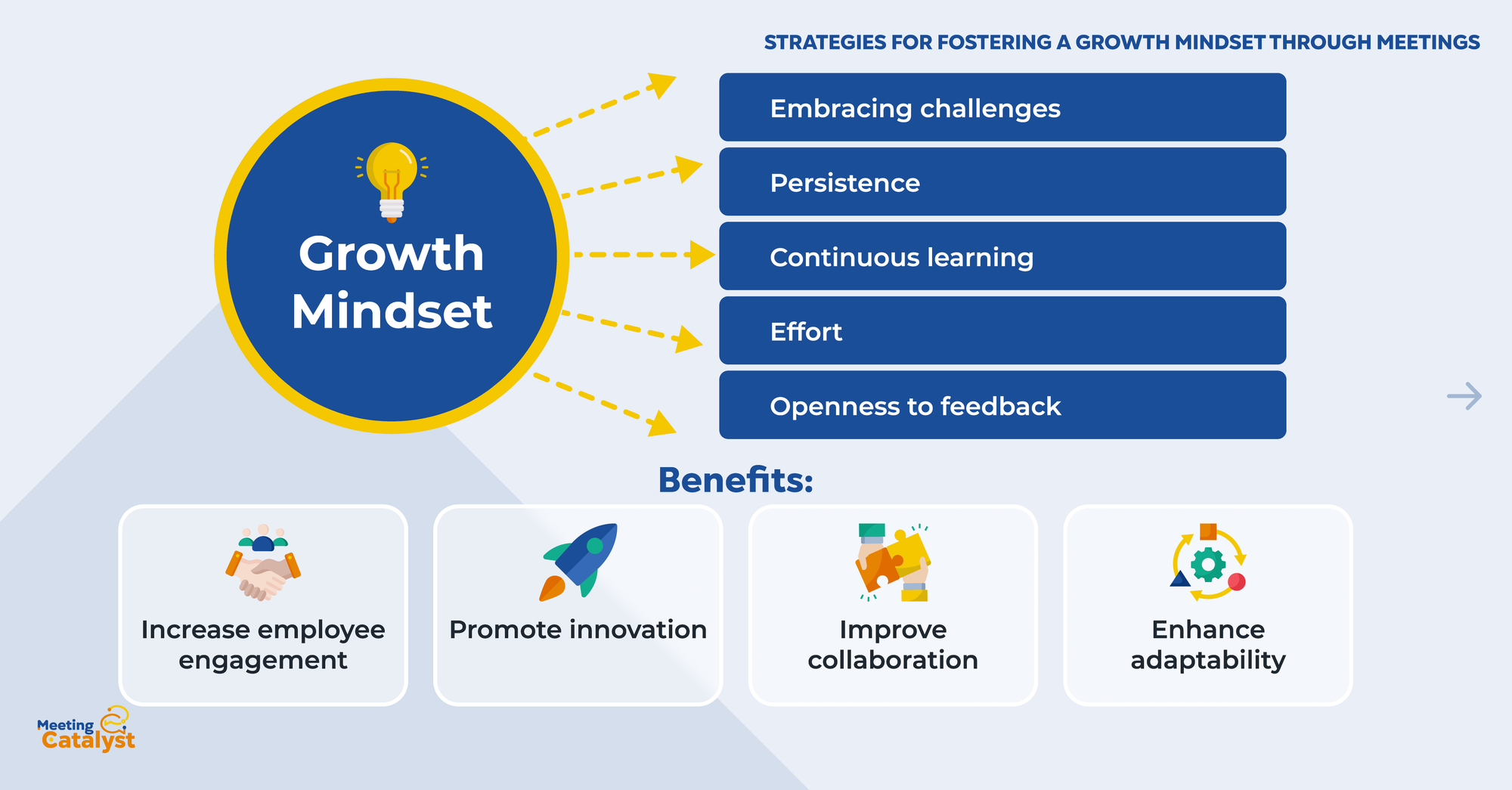
Before diving into strategies for fostering a growth mindset in meetings, it's essential to have a clear understanding of what a growth mindset is and why it's beneficial for your organization. The concept of a growth mindset, developed by psychologist Carol Dweck, has gained widespread attention for its potential to improve performance, adaptability, and overall well-being in various aspects of life.
In a nutshell, a growth mindset is characterized by:
- Embracing challenges: Individuals with a growth mindset view challenges as opportunities for learning and improvement, rather than obstacles to be avoided.
- Persistence: A growth mindset encourages perseverance in the face of setbacks, recognizing that failure is an essential part of the learning process.
- Continuous learning: People with a growth mindset are committed to lifelong learning and actively seek out new knowledge and experiences.
- Effort: Those who embrace a growth mindset understand that effort is the key to unlocking their full potential and are willing to put in the hard work necessary to achieve their goals.
- Openness to feedback: A growth mindset promotes a willingness to accept constructive feedback and use it as a catalyst for improvement.
By fostering a growth mindset in your organization, you can:
- Increase employee engagement: Employees who believe that they can grow and develop their skills are more likely to be motivated and committed to their work.
- Promote innovation: A growth mindset encourages a culture of experimentation, creativity, and risk-taking, which are essential for driving innovation.
- Improve collaboration: When team members view each other as resources for learning and growth, they are more likely to work together effectively and achieve better results.
- Enhance adaptability: In a rapidly changing business environment, organizations that prioritize continuous learning and development are better equipped to adapt and thrive.
Now that we have a solid grasp of the growth mindset concept let's explore the strategies that can help you foster it during your meetings.
Leadership's Role in Promoting a Growth Mindset
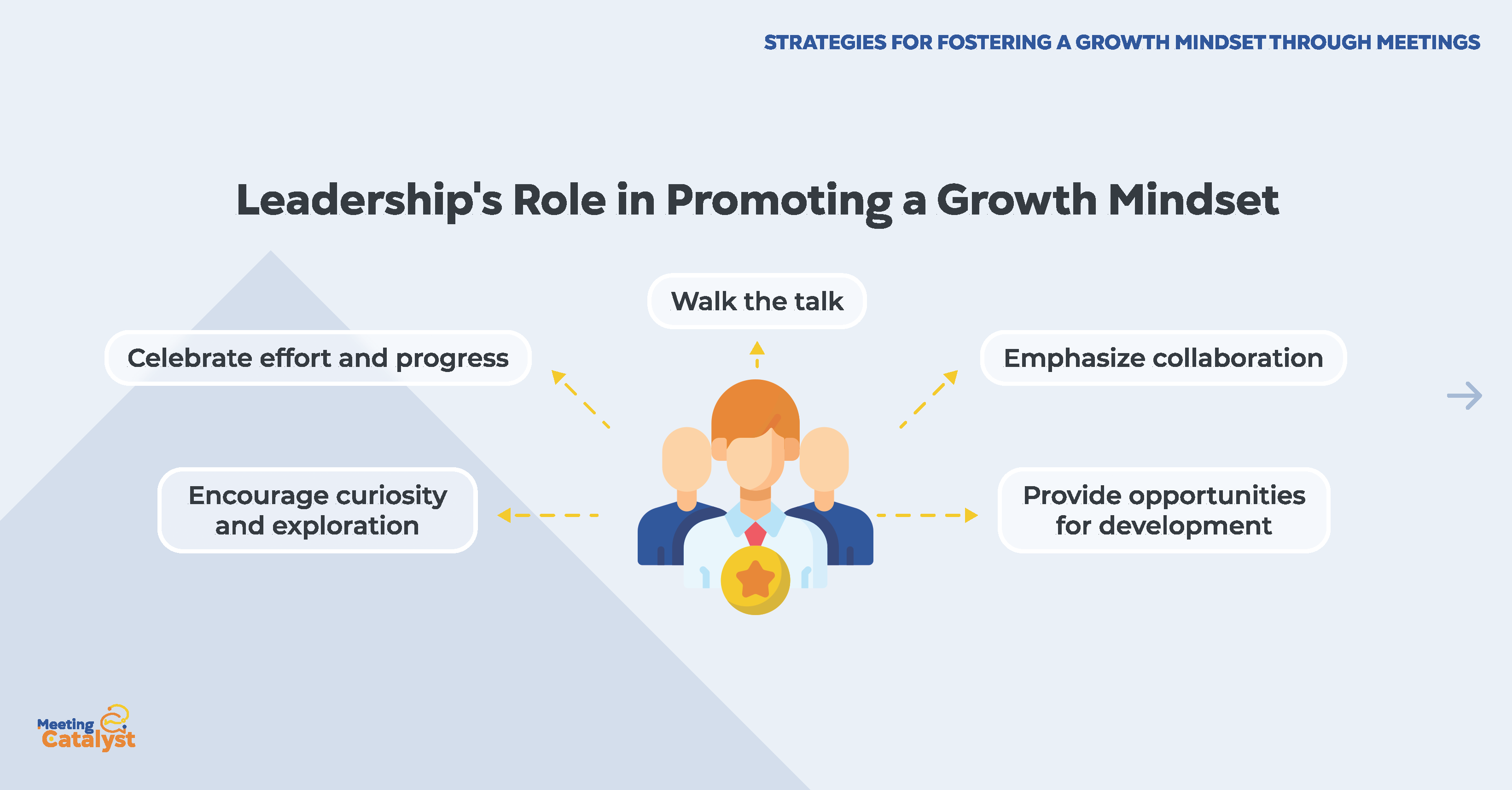
Leaders play a pivotal role in fostering a growth mindset within their organizations. By modeling the right behaviors and creating an environment that supports learning and development, leaders can inspire their teams to embrace challenges, persevere, and grow. Here are some key strategies that leaders can adopt to promote a growth mindset during meetings:
Walk the talk: Demonstrate your commitment to continuous learning by sharing your experiences, challenges, and growth with your team. Be transparent about your own setbacks and lessons learned, showing that failure is an essential part of the journey towards success.
Encourage curiosity and exploration: Cultivate a meeting culture that rewards curiosity and exploration. Ask open-ended questions and encourage team members to share their perspectives, ideas, and insights.
Celebrate effort and progress: Focus on recognizing and celebrating the effort and progress made by your team, rather than just the end results. This helps to reinforce the idea that growth and learning are valuable in their own right.
Emphasize collaboration: Encourage collaboration by creating a supportive environment where team members feel comfortable sharing their thoughts, asking questions, and offering constructive feedback. Promote the idea that everyone can learn from each other and that collective growth benefits the entire organization.
Provide opportunities for development: Make it clear that you support your team's growth by providing opportunities for learning and development, both within and outside of meetings. Offer resources, training, and mentorship to help team members develop their skills and reach their potential.
By taking these steps, leaders can create an environment that nurtures a growth mindset and helps team members approach meetings as opportunities for collective learning and improvement.
Creating an Environment that Encourages Risk-taking and Experimentation
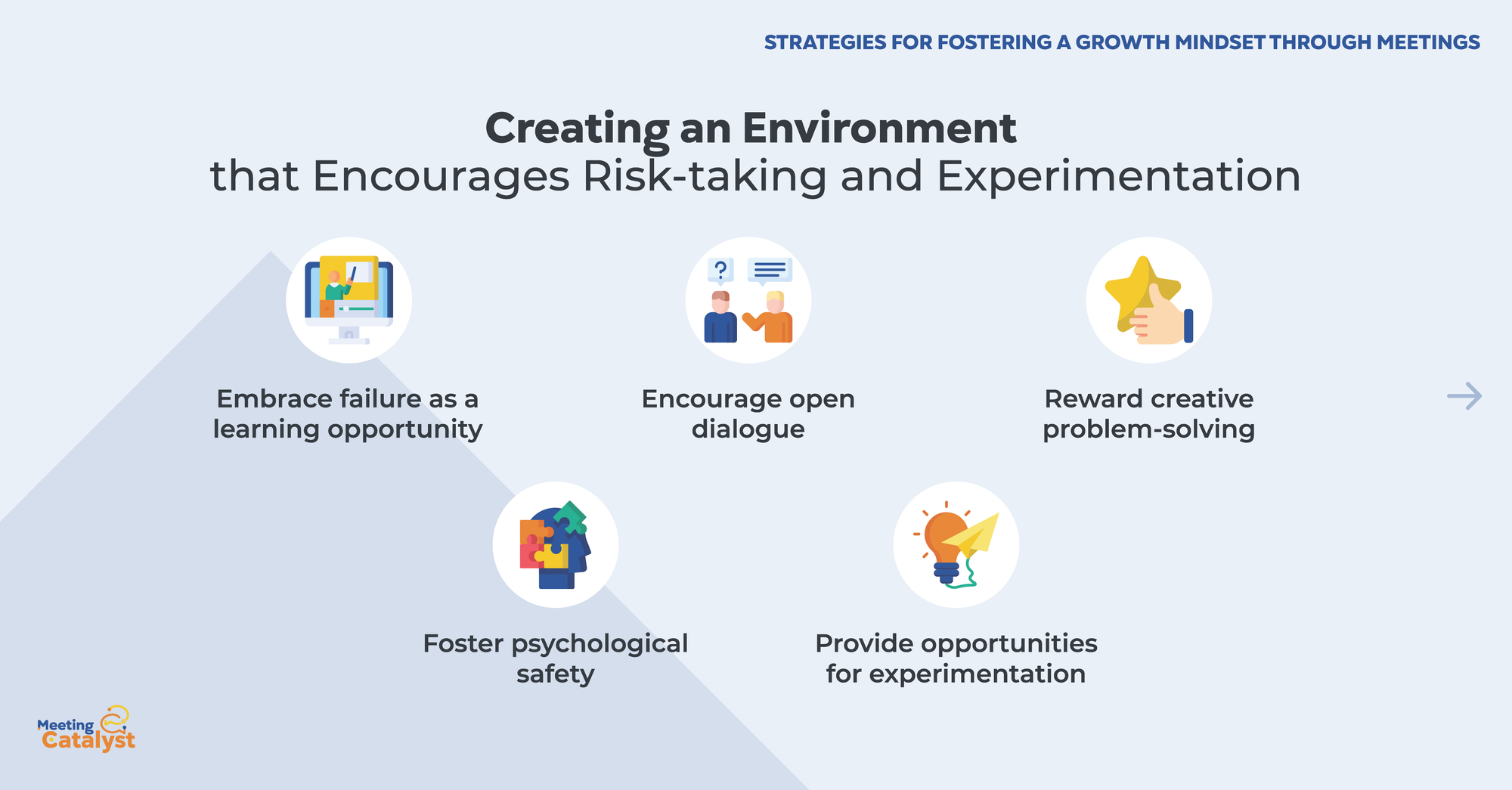
One of the key components of fostering a growth mindset is creating an environment where team members feel safe to take risks and experiment with new ideas. By encouraging innovation and embracing failures as learning opportunities, companies can unlock their team's full potential. Here are some strategies for cultivating a risk-taking and experimental atmosphere during meetings:
Embrace failure as a learning opportunity: Reinforce the idea that failures and setbacks are valuable learning experiences, rather than something to be avoided. Share stories of how past failures led to growth and success, and encourage team members to view challenges as opportunities for improvement.
Encourage open dialogue: Create a meeting culture that values open and honest communication. Encourage team members to voice their opinions, ask questions, and share their concerns without fear of judgment or repercussions.
Reward creative problem-solving: Recognize and celebrate instances of creative problem-solving and innovative thinking, even if the ideas don't ultimately lead to success. This helps to reinforce the message that it's essential to think outside the box and take risks in order to grow.
Foster psychological safety: Work to create an environment where team members feel safe to express their ideas, ask questions, and admit mistakes. Establish trust by being open, honest, and empathetic, and ensure that feedback is provided in a constructive and supportive manner.
Provide opportunities for experimentation: Encourage team members to experiment with new approaches and ideas during meetings. This could involve trying out different problem-solving techniques, brainstorming unconventional solutions, or testing new ways of collaborating and communicating.
By implementing these strategies, you can create an environment that promotes risk-taking and experimentation, helping your team to develop a growth mindset and reach their full potential.
Effective Communication Strategies for Growth Mindset Meetings
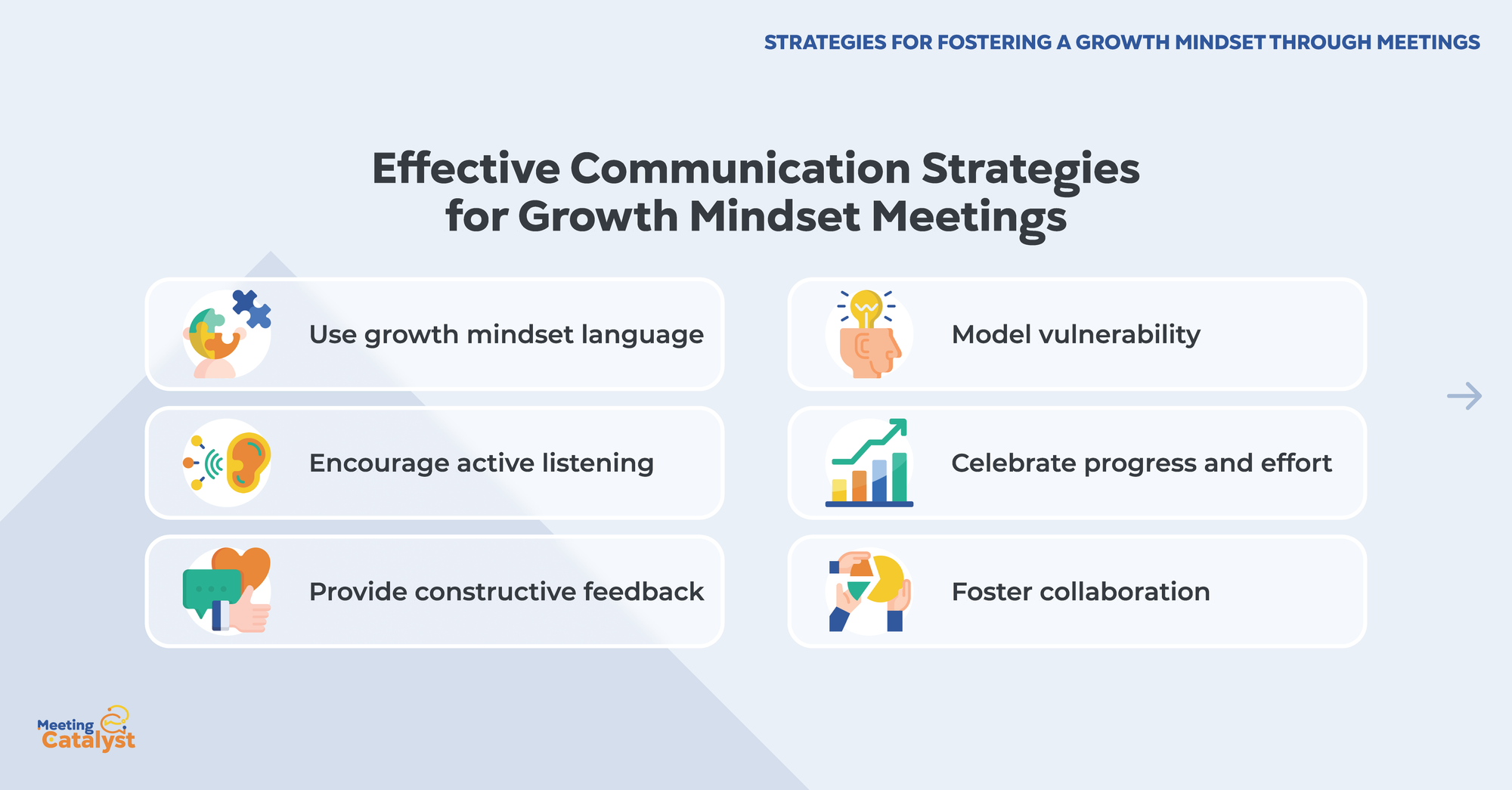
To foster a growth mindset culture within your organization, it's crucial to implement effective communication strategies during meetings. Clear and open communication helps create an environment of trust, collaboration, and continuous learning. Here are some communication techniques to promote a growth mindset during meetings:
Use growth mindset language: Frame challenges and obstacles as opportunities for growth and learning. Replace phrases like "I can't do this" with "I can't do this yet," emphasizing the potential for improvement with effort and persistence.
Encourage active listening: Promote active listening among team members by giving everyone a chance to speak, asking open-ended questions, and summarizing key points. This helps ensure that everyone's ideas are heard and valued, fostering an inclusive environment.
Provide constructive feedback: Offer feedback that focuses on specific behaviors and actions, rather than personal traits or characteristics. Highlight areas for improvement and suggest strategies for growth, rather than focusing solely on shortcomings.
Model vulnerability: Leaders should model vulnerability by admitting their own mistakes and areas for growth. This helps create an atmosphere of trust and encourages team members to be open about their own challenges and areas for improvement.
Celebrate progress and effort: Recognize and celebrate the effort and progress made by team members, rather than just focusing on the end result. This helps reinforce the idea that learning and growth are valuable, even when the desired outcome is not yet achieved.
Foster collaboration: Encourage collaboration and teamwork during meetings by assigning group tasks, promoting open dialogue, and providing opportunities for peer-to-peer learning.
By implementing these communication strategies, you can create an environment that encourages continuous learning and growth, helping your team members to adopt a growth mindset and reach their full potential.
Encouraging Collaboration and Team Problem-solving
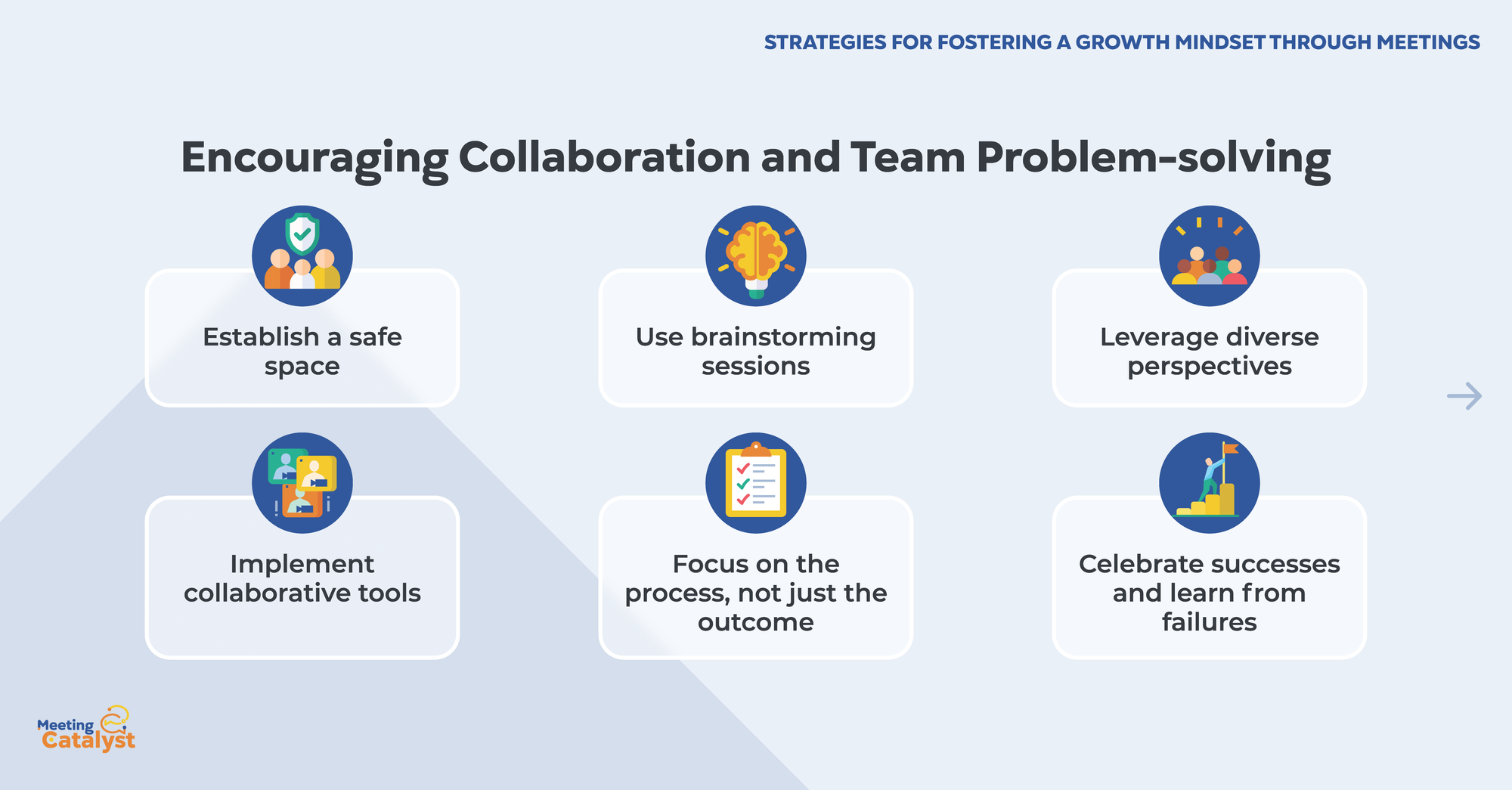
Collaboration and team problem-solving are vital components of a growth mindset culture. When team members work together to find solutions and share ideas, they contribute to a positive and growth-oriented environment. Here are some strategies to encourage collaboration and problem-solving during meetings:
Establish a safe space: Create an environment where team members feel comfortable sharing their ideas, opinions, and concerns. Encourage open communication and reinforce the importance of respecting differing viewpoints.
Use brainstorming sessions: Organize brainstorming sessions that allow team members to contribute their thoughts and ideas freely. Encourage participation from everyone, regardless of their position or level of expertise.
Leverage diverse perspectives: Promote the value of diversity in problem-solving by emphasizing the benefits of having team members with various skills, experiences, and perspectives. Encourage team members to share their unique insights and learn from each other.
Implement collaborative tools: Utilize collaborative tools, such as shared documents, virtual whiteboards, or project management platforms, to facilitate teamwork and encourage team members to contribute their ideas and work together on solutions.
Focus on the process, not just the outcome: Encourage team members to engage in the problem-solving process by discussing the steps they took, what they learned, and how they can improve. This helps reinforce the idea that growth and learning are more important than just achieving the desired result.
Celebrate successes and learn from failures: Recognize and celebrate the team's successes, as well as the lessons learned from failures. This helps promote a growth mindset by reinforcing the idea that both success and failure are valuable learning experiences.
By incorporating these strategies into your meetings, you can foster a growth mindset culture that values collaboration and team problem-solving, ultimately leading to improved performance and a more innovative and adaptable organization.
Implementing Continuous Feedback and Reflection
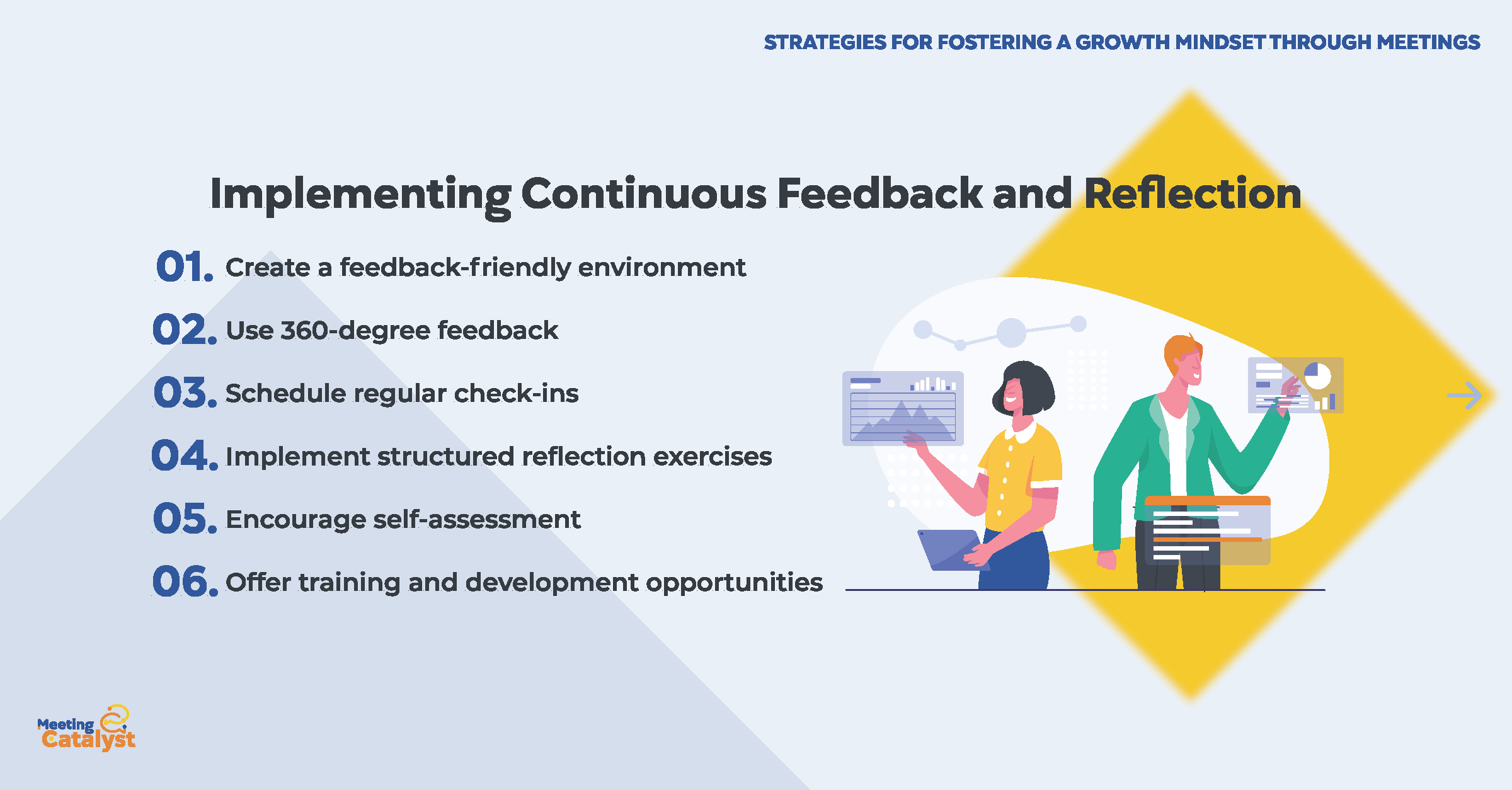
In a growth mindset culture, continuous feedback and reflection are essential for ongoing improvement and development. Incorporating these practices into meetings can help team members identify areas for growth, learn from their experiences, and ultimately become more effective and adaptable. Here are some strategies for implementing continuous feedback and reflection during meetings:
Create a feedback-friendly environment: Encourage open and honest feedback by creating a safe space where team members feel comfortable sharing their thoughts and observations. Emphasize the importance of providing constructive feedback, focusing on areas for improvement, and offering support for growth.
Use 360-degree feedback: Implement 360-degree feedback systems that enable team members to receive feedback from their peers, subordinates, and managers. This provides a well-rounded view of their performance and helps identify areas for development.
Schedule regular check-ins: Set aside time during meetings for team members to share their progress, discuss challenges they have faced, and reflect on their experiences. This practice encourages self-awareness and fosters a culture of continuous learning.
Implement structured reflection exercises: Introduce structured reflection exercises, such as after-action reviews or lessons learned sessions, to help team members analyze their performance and identify areas for improvement.
Encourage self-assessment: Provide opportunities for team members to assess their own performance and growth, using self-assessment tools or by setting personal goals and tracking progress.
Offer training and development opportunities: Support team members in their growth by offering relevant training, resources, and opportunities for professional development. Encourage them to apply their newfound knowledge and skills in their daily work and share their learnings with the team.
By integrating continuous feedback and reflection into your meetings, you can foster a growth mindset culture that promotes ongoing improvement, learning, and development. This, in turn, will lead to a more resilient and adaptable organization, better equipped to navigate the challenges of today's rapidly evolving business landscape.
Setting Goals and Tracking Progress
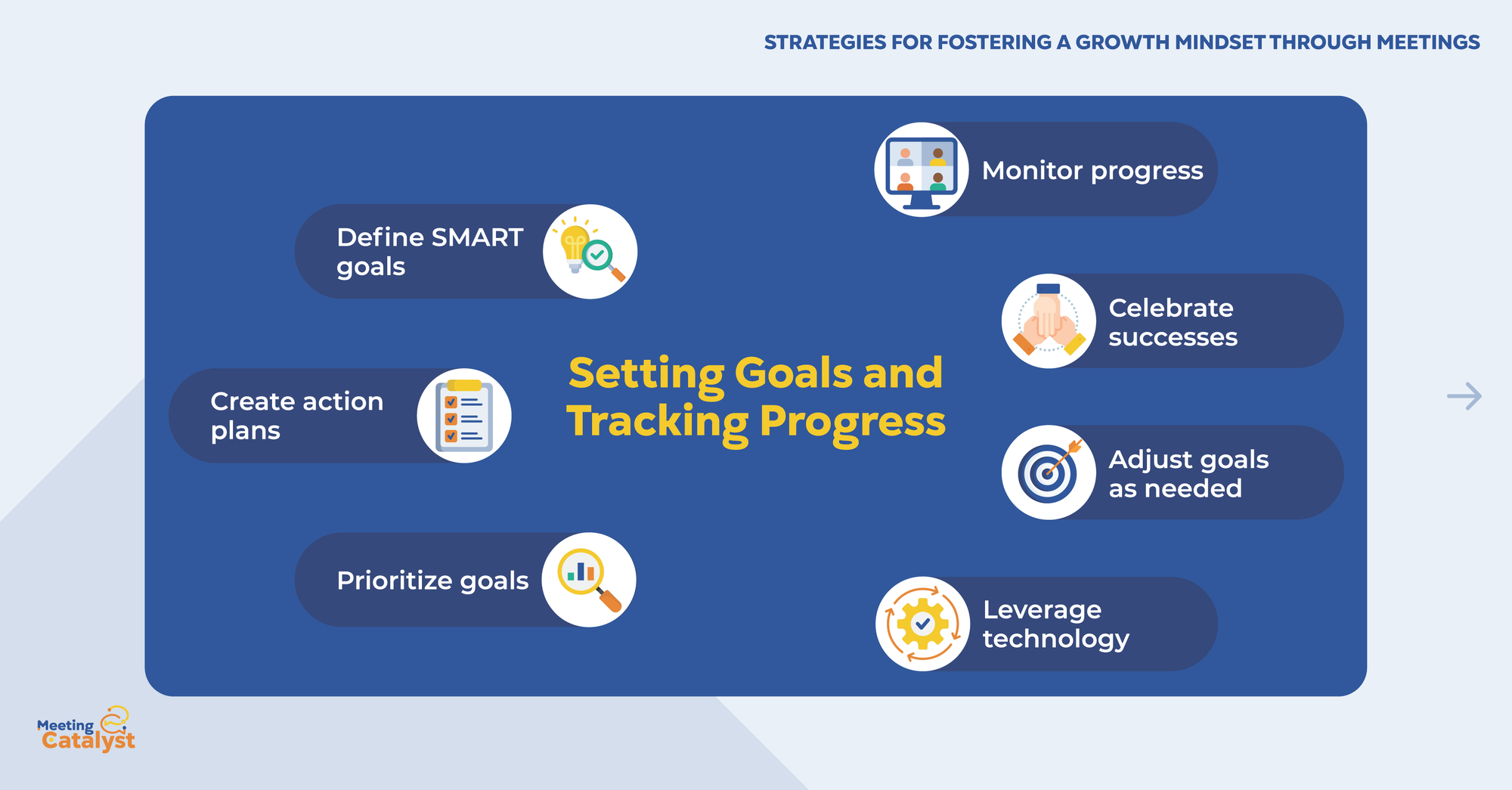
One of the key aspects of fostering a growth mindset in meetings is setting goals and tracking progress. By establishing clear objectives and monitoring progress toward those objectives, team members can stay focused on growth and improvement, as well as celebrate their achievements. Here are some strategies for setting goals and tracking progress in meetings:
Define SMART goals: Encourage team members to set Specific, Measurable, Achievable, Relevant, and Time-bound (SMART) goals. This helps ensure that goals are clear, actionable, and achievable within a specific timeframe.
Create action plans: Once goals are established, work with team members to create action plans outlining the steps they need to take to achieve their objectives. This process encourages accountability and ownership of their growth journey.
Prioritize goals: Help team members prioritize their goals based on their importance and urgency. This can help them focus on the most critical areas for growth and development.
Monitor progress: Regularly review progress towards goals during meetings, discussing any challenges or obstacles encountered and brainstorming solutions to overcome them. This practice promotes ongoing growth and development.
Celebrate successes: Acknowledge and celebrate team members' achievements as they reach their goals. Recognizing their hard work and accomplishments can boost motivation and reinforce the growth mindset culture.
Adjust goals as needed: As team members progress, their goals may evolve. Encourage them to regularly reassess their objectives and make adjustments as necessary, maintaining a focus on growth and improvement.
Leverage technology: Utilize project management and goal-tracking tools to help team members keep track of their progress and stay accountable for their goals. These tools can also facilitate communication and collaboration among the team.
By setting goals and tracking progress in meetings, you can help team members stay focused on their growth journey and create a culture that values continuous improvement and learning. This approach ultimately leads to a more adaptable and resilient organization, better prepared to navigate the challenges of today's ever-changing business landscape.
Adapting Growth Mindset Strategies for Remote and Hybrid Meetings
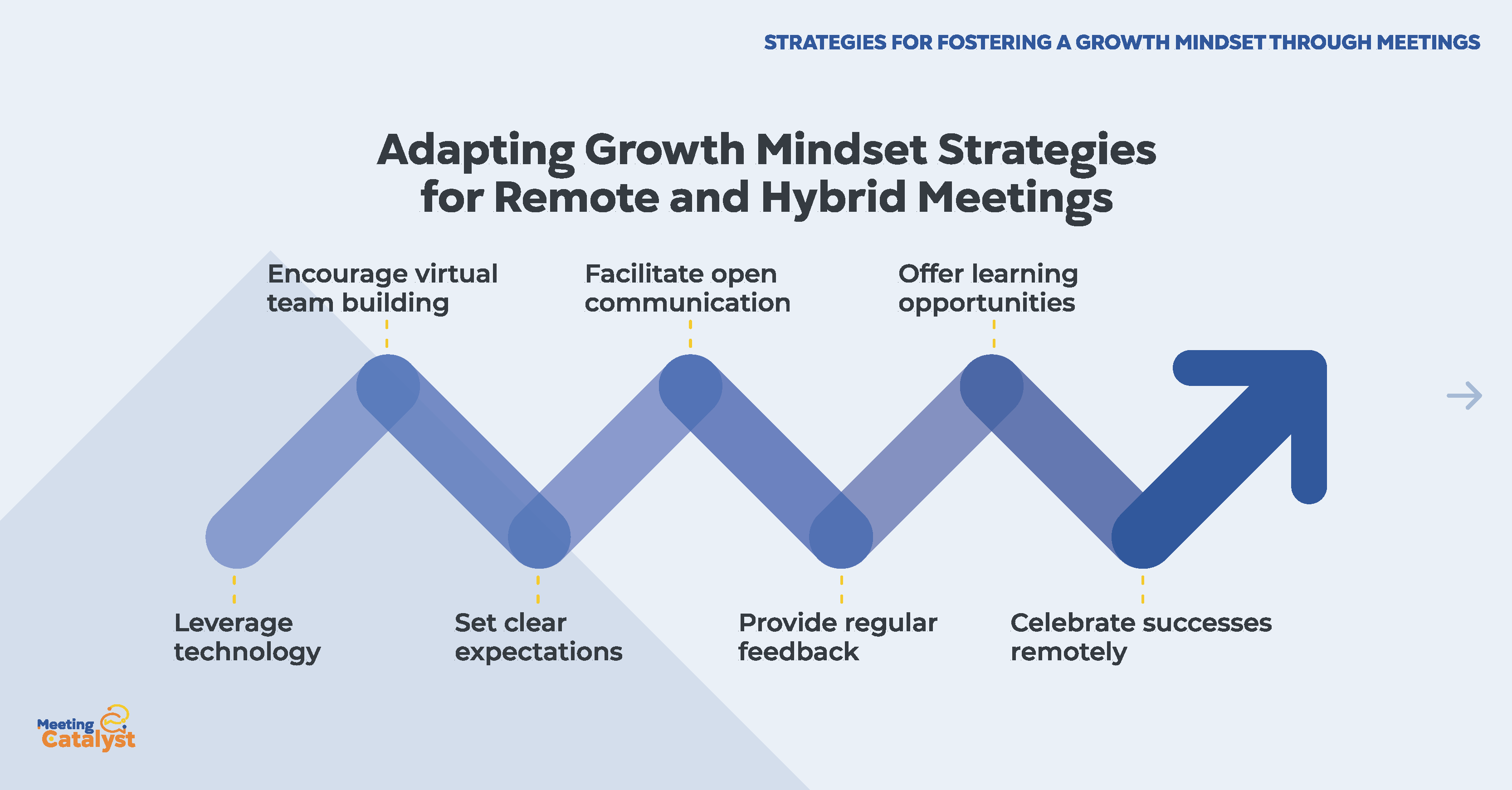
As remote and hybrid work environments become increasingly common, it's essential to adapt growth mindset strategies to suit these new meeting formats. Here are some ways to effectively promote a growth mindset in remote and hybrid meetings:
Leverage technology: Use digital tools and platforms to facilitate collaboration, communication, and goal-setting. Platforms like Zoom, Microsoft Teams, and Slack can help keep team members connected and engaged, even when they're not physically in the same location.
Encourage virtual team building: Foster a sense of community and collaboration among remote and hybrid team members through virtual team-building activities. These could include online games, workshops, or even virtual coffee breaks.
Set clear expectations: Ensure all team members understand their roles, responsibilities, and objectives in remote and hybrid meetings. This clarity helps maintain focus and encourages a growth mindset culture.
Facilitate open communication: Create a safe and inclusive space for team members to openly share their thoughts, ideas, and concerns, both in meetings and through digital channels. This encourages a culture of learning and collaboration.
Provide regular feedback: Offer consistent feedback and support to remote and hybrid team members, making sure they know their efforts are valued and their growth is a priority. This could involve scheduled check-ins, performance reviews, or informal one-on-one conversations.
Offer learning opportunities: Encourage remote and hybrid team members to take advantage of online resources, webinars, and courses to continue their professional development. This emphasis on learning supports a growth mindset culture.
Celebrate successes remotely: Acknowledge and celebrate team members' achievements, even when they're working remotely. Use digital platforms like Slack or Microsoft Teams to share successes and milestones with the entire team, maintaining a sense of community and reinforcing a growth mindset.
By adapting growth mindset strategies for remote and hybrid meetings, you can ensure that your team remains focused on continuous improvement, learning, and collaboration, no matter where they are located. This approach helps create a resilient and adaptable workforce, better equipped to face the challenges of the modern business world.
Conclusion
In today's fast-paced and competitive business environment, fostering a growth mindset through meetings is more important than ever. By understanding the growth mindset and implementing strategies that promote learning, collaboration, and continuous improvement, companies can create an environment that supports employee development and drives business success.
To recap, the key strategies for fostering a growth mindset through meetings include:
- Understanding the growth mindset and its benefits
- Leadership's role in promoting a growth mindset
- Creating an environment that encourages risk-taking and experimentation
- Employing effective communication strategies for growth mindset meetings
- Encouraging collaboration and team problem-solving
- Implementing continuous feedback and reflection
- Setting goals and tracking progress
- Adapting growth mindset strategies for remote and hybrid meetings
Remember, the journey towards cultivating a growth mindset culture is an ongoing process that requires consistent effort and commitment from both leaders and employees. By embracing these strategies and leveraging the power of meetings, your organization can unlock its full potential and achieve lasting success.